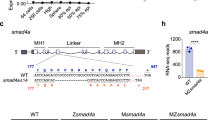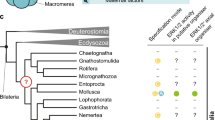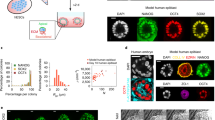Abstract
Several studies have implicated Wnt signalling in primary axis formation during vertebrate embryogenesis, yet no Wnt protein has been shown to be essential for this process1,2,3. In the mouse, primitive streak formation is the first overt morphological sign of the anterior-posterior axis. Here we show that Wnt3 is expressed before gastrulation in the proximal epiblast of the egg cylinder, then is restricted to the posterior proximal epiblast and its associated visceral endoderm and subsequently to the primitive streak and mesoderm. Wnt3–/– mice develop a normal egg cylinder but do not form a primitive streak, mesoderm or node. The epiblast continues to proliferate in an undifferentiated state that lacks anterior-posterior neural patterning, but anterior visceral endoderm markers are expressed and correctly positioned. Our results suggest that regional patterning of the visceral endoderm is independent of primitive streak formation, but the subsequent establishment of anterior-posterior neural pattern in the ectoderm is dependent on derivatives of the primitive streak. These studies provide genetic proof for the requirement of Wnt3 in primary axis formation in the mouse.
This is a preview of subscription content, access via your institution
Access options
Subscribe to this journal
Receive 12 print issues and online access
$209.00 per year
only $17.42 per issue
Buy this article
- Purchase on Springer Link
- Instant access to full article PDF
Prices may be subject to local taxes which are calculated during checkout




Similar content being viewed by others
References
McMahon, A.P. & Moon, R.T. Ectopic expression of the proto-oncogene int-1 in Xenopus embryos leads to duplication of the embryonic axis. Cell 58, 1075–1084 (1989).
Popperl, H. et al. Misexpression of Cwnt8C in the mouse induces an ectopic embryonic axis and causes a truncation of the anterior neuroectoderm. Development 124, 2997–3005 (1997).
Zheng, L. et al. The mouse Fused locus encodes Axin, an inhibitor of the Wnt signaling pathway that regulates embryonic axis formation. Cell 90, 181–192 (1997).
Cadigan, K.M. & Nusse, R. Wnt signaling: a common theme in animal development. Genes Dev. 11, 3286–3305 (1997).
Roelink, H., Wagenaar, E., Lopes da Silva, S. & Nusse, R. Wnt-3, a gene activated by proviral insertion in mouse mammary tumors, is homologous to int-1/Wnt-1 and is normally expressed in mouse embryos and adult brain. Proc. Natl Acad. Sci. USA 87, 4519–4523 (1990).
Christian, J.L., Gavin, B.J., McMahon, A.P. & Moon, R.T. Isolation of cDNAs partially encoding four Xenopus Wnt-1/int-1-related proteins and characterization of their transient expression during embryonic development. Dev. Biol. 143, 230–234 (1991).
Krauss, S., Korzh, V., Fjose, A. & Johansen, T. Expression of four zebrafish wnt-related genes during embryogenesis. Development 116, 249–259 (1992).
Roelink, H., Wang, J., Black, D.M., Solomon, E. & Nusse, R. Molecular cloning and chromosomal localization to 17q21 of the human WNT3 gene. Genomics 17, 790–792 (1993).
Roelink, H. & Nusse, R. Expression of two members of the Wnt family during mouse development—restricted temporal and spatial patterns in the developing neural tube. Genes Dev. 5, 381–388 (1991).
Parr, B.A., Shea, M.J., Vassileva, G. & McMahon, A.P. Mouse Wnt genes exhibit discrete domains of expression in the early embryonic CNS and limb buds. Development 119, 247–261 (1993).
Simeone, A. et al. A vertebrate gene related to orthodenticle contains a homeodomain of the bicoid class and demarcates anterior neuroectoderm in the gastrulating mouse embryo. EMBO J. 12, 2735–2747 (1993).
Rosner, M.H. et al. A POU-domain transcription factor in early stem cells and germ cells of the mammalian embryo. Nature 345, 686–692 (1990).
Lawson, K.A. et al. Bmp4 is required for the generation of primordial germ cells in the mouse embryo. Genes Dev. 13, 424–436 (1999).
Thomas, P. & Beddington, R.S.P. Anterior primitive endoderm may be responsible for patterning the anterior neural plate in the mouse embryo. Curr. Biol. 6, 1487–1496 (1996).
Barnes, J.D., Crosby, J.L., Jones, C.M., Wright, C.V.E. & Hogan, B.L.M. Embryonic expression of Lim-1, the mouse homolog of Xlim-1, suggests a role in lateral mesoderm differentiation and neurogenesis. Dev. Biol. 161, 168–178 (1994).
Belo, J.A. et al. Cerberus-like is a secreted factor with neuralizing activity expressed in the anterior primitive endoderm of the mouse gastrula. Mech. Dev. 68, 45–57 (1997).
Moon, R.T. & Kimelman, D. From cortical rotation to organizer gene expression: toward a molecular explanation of axis specification in Xenopus. Bioessays 20, 536–545 (1998).
Tanaka, S., Kunath, T., Hadjantonakis, A.K., Nagy, A. & Rossant, J. Promotion of trophoblast stem cell proliferation by FGF4. Science 282, 2072–2075 (1998).
Tam, P.P.L., Goldman, D., Camus, A. & Schoenwolf, G.C. Early events of somitogenesis in higher vertebrates: allocation of precursor cells during gastrulation and the organization of a meristic pattern in the paraxial mesoderm. Curr. Topics Dev. Biol. (in press).
Tam, P.P.L. & Behringer, R.R. Mouse gastrulation: the formation of a mammalian body plan. Mech. Dev. 68, 3–25 (1997).
Beddington, R.S.P. & Robertson, E.J. Axis development and early asymmetry in mammals. Cell 96, 195–209 (1999).
Ang, S.-L. & Rossant, J. Anterior mesendoderm induces mouse Engrailed genes in explant cultures. Development 118, 139–49 (1993).
Ang, S.L., Conlon, R.A., Jin, O. & Rossant, J. Positive and negative signals from mesoderm regulate the expression of mouse Otx2 in ectoderm explants. Development 120, 2979–2989 (1994).
Ramírez-Solis, R., Liu, P. & Bradley, A. Chromosome engineering in mice. Nature 378, 720–724.
Liu, P., Zhang, H., McLellan, A., Vogel, H. & Bradley, A. Embryonic lethality and tumorigenesis caused by segmental aneuploidy on mouse chromosome 11. Genetics 150, 1155–1168 (1998).
Zheng, B. et al. Engineering a mouse balancer chromosome. Nature Genet. 22, 375–381 (1999).
Wilkinson, D.G. in In Situ Hybridization (ed. Wilkinson, D.G.) 75–83 (IRL, Oxford, 1992).
Acknowledgements
We thank S.-L. Ang, T. Gridley, B. Herrmann, B. Hogan, A. Joyner, K. Mahon, H. Schöler, W. Shawlot and D. Wilkinson for in situ hybridization probes; S. Vashnav for histological support; C. Dinh for technical support; and B. Shawlot, P. Tam and C. Wright for helpful comments on the manuscript. This study was supported by a grant from the Human Frontiers Science Program to R.R.B. and from the National Institutes of Health (NCI) to A.B. P.L. was supported by a predoctoral fellowship from the Markey Foundation. M.J.S. was supported by a postdoctoral fellowship from the US Department of Defense.
Author information
Authors and Affiliations
Corresponding authors
Rights and permissions
About this article
Cite this article
Liu, P., Wakamiya, M., Shea, M. et al. Requirement for Wnt3 in vertebrate axis formation. Nat Genet 22, 361–365 (1999). https://doi.org/10.1038/11932
Received:
Accepted:
Issue Date:
DOI: https://doi.org/10.1038/11932
This article is cited by
-
Intercellular exchange of Wnt ligands reduces cell population heterogeneity during embryogenesis
Nature Communications (2023)
-
Induction of primordial germ cell-like cells from common marmoset embryonic stem cells by inhibition of WNT and retinoic acid signaling
Scientific Reports (2023)
-
Optimizing Generation of Stem Cell-Derived Islet Cells
Stem Cell Reviews and Reports (2022)
-
Role of TGFβ1 and WNT6 in FGF2 and BMP4-driven endothelial differentiation of murine embryonic stem cells
Angiogenesis (2022)
-
Recent progress in pancreatic islet cell therapy
Inflammation and Regeneration (2021)



